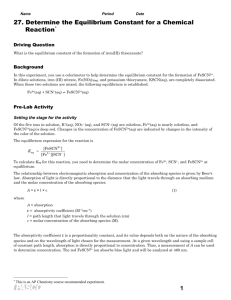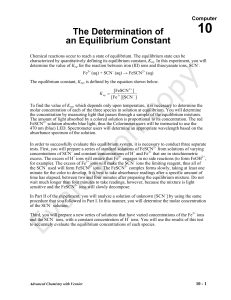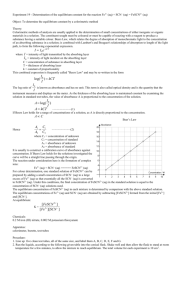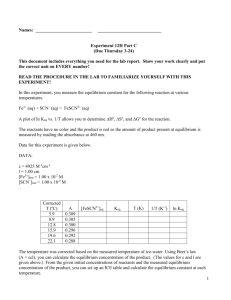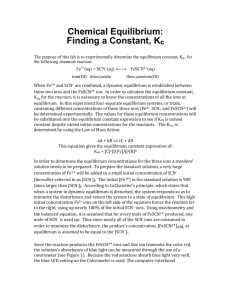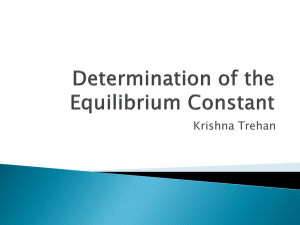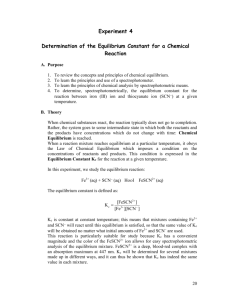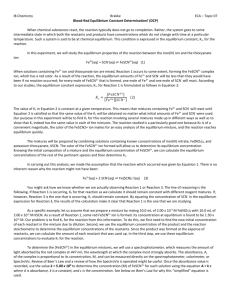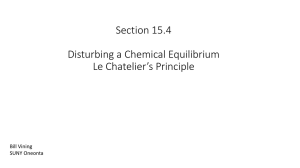K eq lab
advertisement
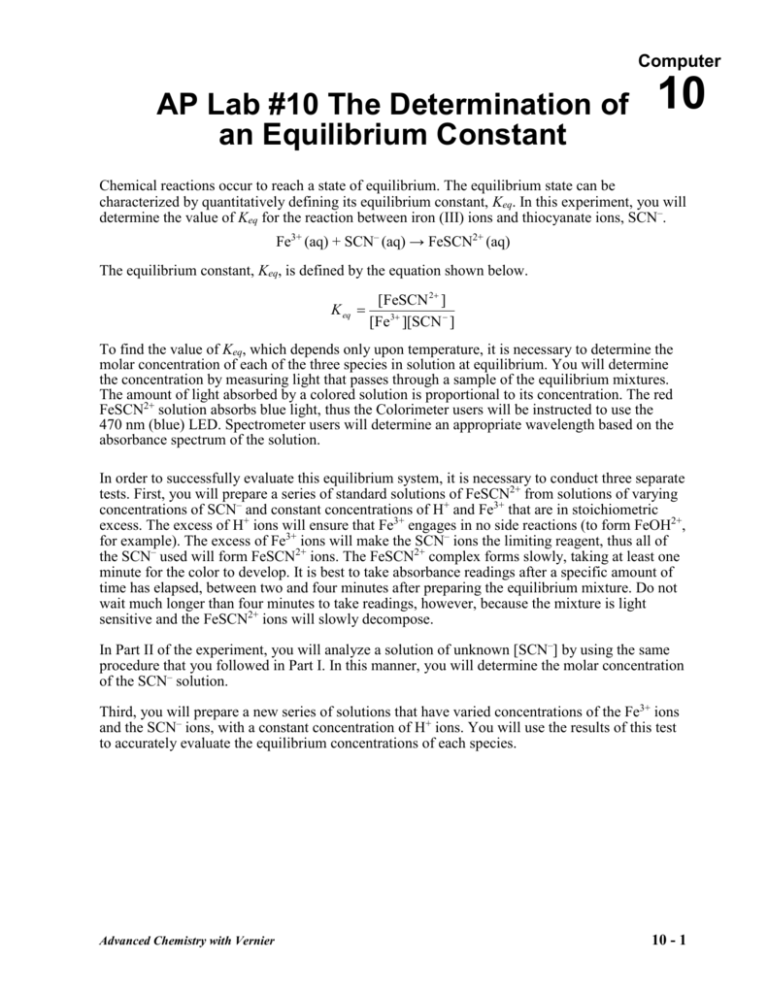
Computer AP Lab #10 The Determination of an Equilibrium Constant 10 Chemical reactions occur to reach a state of equilibrium. The equilibrium state can be characterized by quantitatively defining its equilibrium constant, Keq. In this experiment, you will determine the value of Keq for the reaction between iron (III) ions and thiocyanate ions, SCN–. Fe3+ (aq) + SCN– (aq) → FeSCN2+ (aq) The equilibrium constant, Keq, is defined by the equation shown below. K eq [FeSCN 2 ] [Fe 3 ][SCN ] To find the value of Keq, which depends only upon temperature, it is necessary to determine the molar concentration of each of the three species in solution at equilibrium. You will determine the concentration by measuring light that passes through a sample of the equilibrium mixtures. The amount of light absorbed by a colored solution is proportional to its concentration. The red FeSCN2+ solution absorbs blue light, thus the Colorimeter users will be instructed to use the 470 nm (blue) LED. Spectrometer users will determine an appropriate wavelength based on the absorbance spectrum of the solution. In order to successfully evaluate this equilibrium system, it is necessary to conduct three separate tests. First, you will prepare a series of standard solutions of FeSCN2+ from solutions of varying concentrations of SCN– and constant concentrations of H+ and Fe3+ that are in stoichiometric excess. The excess of H+ ions will ensure that Fe3+ engages in no side reactions (to form FeOH2+, for example). The excess of Fe3+ ions will make the SCN– ions the limiting reagent, thus all of the SCN– used will form FeSCN2+ ions. The FeSCN2+ complex forms slowly, taking at least one minute for the color to develop. It is best to take absorbance readings after a specific amount of time has elapsed, between two and four minutes after preparing the equilibrium mixture. Do not wait much longer than four minutes to take readings, however, because the mixture is light sensitive and the FeSCN2+ ions will slowly decompose. In Part II of the experiment, you will analyze a solution of unknown [SCN–] by using the same procedure that you followed in Part I. In this manner, you will determine the molar concentration of the SCN– solution. Third, you will prepare a new series of solutions that have varied concentrations of the Fe3+ ions and the SCN– ions, with a constant concentration of H+ ions. You will use the results of this test to accurately evaluate the equilibrium concentrations of each species. Advanced Chemistry with Vernier 10 - 1 Computer 10 OBJECTIVES In this experiment, you will Prepare and test standard solutions of FeSCN2+ in equilibrium. Test solutions of SCN– of unknown molar concentration. Determine the molar concentrations of the ions present in an equilibrium system. Determine the value of the equilibrium constant, Keq, for the reaction. MATERIALS Computer Vernier computer interface* Logger Pro Colorimeter or Spectrometer plastic cuvette graduated 10.0 mL pipette pipet pump or bulb 10 mL graduated cylinder plastic Beral pipets Eight small (100-250) beakers 0.200 M iron (III) nitrate, Fe(NO3)3, solution in 1.0 M HNO3 0.0020 M iron (III) nitrate, Fe(NO3)3, solution in 1.0 M HNO3 0.0020 M thiocyanate, SCN– unknown KSCN solution Temperature Probe distilled water 50 mL volumetric flask tissue PRE-LAB EXERCISE Add this lab to your table of contents, write a purpose and table of reagents for this lab For the solutions that you will prepare in Step 2 of Part I below, calculate the [FeSCN2+]. Presume that all of the SCN– ions react. In Part I of the experiment, mol of SCN– = mol of FeSCN2+. Thus, the calculation of [FeSCN2+] is: mol FeSCN2+ ÷ L of total solution. Record these values in the table below. Beaker number [FeSCN2+] 1 2 3 4 (blank) 10 - 2 0.00 M Advanced Chemistry with Vernier The Determination of an Equilibrium Constant PROCEDURE Part I Prepare and Test Standard Solutions 1. Obtain and wear goggles. 2. Label five small beakers 1-5. Obtain small volumes of 0.200 M Fe(NO3)3, 0.0020 M SCN–, and distilled water. CAUTION: This lab also uses a .002 M Fe(NO3)3 solution. Make certain you have the correct concentration. Prepare four solutions according to the chart below (The fifth beaker is a blank.). Use a 10.0 mL pipet and a pipet pump or bulb to transfer each solution to a 50 mL volumetric flask. Mix each solution thoroughly. Measure and record the temperature of one of the above solutions to use as the temperature for the equilibrium constant, Keq. Beaker number 0.200 M Fe(NO3)3 (mL) 0.0020 M SCN– (mL) H2O (mL) 1 2 3 4 Blank 5.0 5.0 5.0 5.0 5.0 5.0 4.0 3.0 2.0 0.0 40.0 41.0 42.0 43.0 45.0 Note: The fifth beaker is prepared to be used as a blank for your spectrometer (or Colorimeter) calibration. It will have a slightly yellow color due to the presence of Fe(NO3)3. By calibrating with this solution as your blank, instead of distilled water, you will account for this slight yellow color. 3. Prepare a blank by filling a cuvette 3/4 full with beaker #5. To correctly use cuvettes, remember: Wipe the outside of each cuvette with a lint-free tissue. Handle cuvettes only by the top edge of the ribbed sides. Dislodge any bubbles by gently tapping the cuvette on a hard surface. Always position the cuvette so the light passes through the clear sides. 4. Connect the Colorimeter to the computer interface. Prepare the computer for data collection by opening the file “10 Equilibrium” from the Advanced Chemistry with Vernier folder of Logger Pro. 5. Open the Colorimeter lid, insert the blank, and close the lid. a) Calibrate the Colorimeter and prepare to test the standard solutions. b) Press the < or > button on the Colorimeter to select a wavelength of 470 nm (Blue). c) Press the CAL button until the red LED begins to flash and then release the CAL button. d) When the LED stops flashing, the calibration is complete. e) Empty the water from the blank cuvette. Using the solution in Beaker 1, rinse the cuvette twice with ~1 mL amounts and then fill it 3/4 full. Wipe the outside with a tissue, place it in the Colorimeter. Advanced Chemistry with Vernier 10 - 3 Computer 10 6. Collect absorbance-concentration data for the five standard equilibrium mixtures. a) Leave the cuvette, containing the Beaker 1 mixture, in the device (Colorimeter or Spectrometer). Close the lid on the Colorimeter.) b) Click . Click , type the concentration of FeSCN2+ (from your pre-lab calculations) in the edit box, and click . c) Discard the cuvette contents as directed. Rinse and fill the cuvette with the solution in Beaker 2 and place it in the device. After the reading stabilizes, click , type the concentration of FeSCN2+ (from your pre-lab calculations) in the edit box, and click . d) Repeat Part b of this step to measure the absorbance of the solutions in Beakers 3, 4, and 5. e) Click when you have finished collecting data. Click the Examine button, , and write down the absorbance values for each data pair in your data table. 7. Click the Linear Fit button, . A best-fit linear regression equation will be plotted for your data. This line should pass near or through the data points and the origin of the graph. Leave the equation in place on the graph and proceed to Step 9. Part II Test an Unknown Solution of SCN– 8. Obtain about 10 mL of the unknown SCN– solution. Use a pipet to measure out 5.0 mL of the unknown into a clean and dry 100 mL beaker. Add precisely 5.0 mL of 0.200 M Fe(NO3)3 and 40.0 mL of distilled water to the beaker. Stir the mixture thoroughly. 9. Using the solution in the beaker, rinse a cuvette twice with ~1 mL amounts and then fill it 3/4 full. Place the cuvette of unknown in the device. Read the absorbance value displayed in the meter. (Important: The reading in the meter is live, so it is not necessary to click to read the absorbance value.) When the displayed absorbance value stabilizes, record its value in your Data and Calculations table for Parts I and II. 10. Determine the concentration of the unknown SCN– solution. a) Choose Interpolate from the Analyze menu. A vertical cursor now appears on the graph. The cursor’s concentration and absorbance coordinates are displayed in the floating box. b) Move the cursor along the regression line until the absorbance value is approximately the same as the absorbance value you recorded in Step 10. The corresponding concentration value is the concentration of the unknown solution, in mol/L. Record the value in your Data Table for Parts I and II. c) Print the graph and attach it to your lab. 10 - 4 Advanced Chemistry with Vernier The Determination of an Equilibrium Constant Part III Prepare and Test Equilibrium Systems Label three new small beakers A-C. Prepare the solutions according to the chart below. Use 10.0 mL graduated cylinders to measure the solutions. Mix each solution thoroughly. Note: You are using 0.0020 M Fe(NO3)3 in this test. Beaker 0.0020 M Fe(NO3)3 (mL) 0.0020 M SCN– (mL) H2O (mL) A B C 3.00 3.00 3.00 3.00 4.00 5.00 4.00 3.00 2.00 11. Collect absorbance-concentration data for the three beakers of equilibrium mixtures. a. Using the solution in Beaker A, rinse the cuvette twice with ~1 mL amounts and then fill it 3/4 full. Wipe the outside with a tissue and place the cuvette in the device (Spectrometer or Colorimeter.) b. Write down, in your data table, the absorbance of the sample in Beaker A. c. Open the Analyze menu and choose Interpolate. Trace along the best-fit line equation to find the FeSCN2+ concentration for the sample in Beaker A. Write down the concentration in your data table. d. Discard the cuvette contents as directed. Rinse and fill the cuvette with the solution in Beaker B and place it in the device. After the reading stabilizes, write down the absorbance in your data table and use the Interpolate function to determine the concentration of the sample. e. Repeat Step d for the mixtures in Beaker C. Advanced Chemistry with Vernier 10 - 5 Computer 10 DATA TABLE Parts I and II Beaker Absorbance 1 2 3 4 Unknown, Part II Concentration Unknown mol/L Part III Beaker Absorbance [FeSCN2+] at equilibrium A B C DATA ANALYSIS 1. 10 - 6 Calculate the concentration of the original unknown KSCN solution (remember the solution calculated in above part II data table is diluted). Advanced Chemistry with Vernier The Determination of an Equilibrium Constant 2. A common method that is used to organize and calculate the concentrations of the species in an equilibrium system is an I.C.E. chart. “I.C.E” stands for Initial concentration, Change in concentration, and the Equilibrium concentration. The initial concentrations of the Fe3+ and the SCN– ions can be calculated from the mixing chart in Part III, Step 11. You have already determined the equilibrium concentration of the FeSCN2+ ions by completing the analysis in Part III. The rest is a little bit of math. BEAKER A Fe3+ SCN– Initial FeSCN2+ 0.00 Change Equilibrium BEAKER B Fe3+ SCN– Initial FeSCN2+ 0.00 Change Equilibrium BEAKER C Fe3+ Initial SCN– FeSCN2+ 0.00 Change Equilibrium Advanced Chemistry with Vernier 10 - 7 Computer 10 10 - 8 3. Write the Keq expression for this equation. 4. Calculate the value of Keq for the reaction for beaker A B and C. Explain how you used the data to calculate Keq. 5. Take an average of the three Keq values. 6. Explain possible causes of variation in the three Keq values. Advanced Chemistry with Vernier
